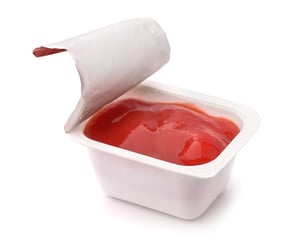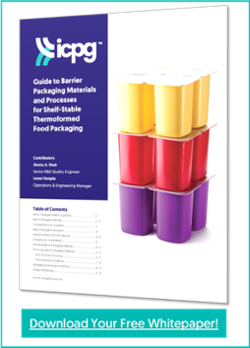 With literally hundreds of material combinations available for rigid thermoforming applications today, understanding the relative processing challenges of monolayer vs multi-layer barrier rollstock is critical when converting the material from rollstock to formed parts. Differing materials and structures require establishing unique process parameters that can have a profound impact on key considerations from minimizing scrap, to maximizing run efficiencies and controlling cost.
With literally hundreds of material combinations available for rigid thermoforming applications today, understanding the relative processing challenges of monolayer vs multi-layer barrier rollstock is critical when converting the material from rollstock to formed parts. Differing materials and structures require establishing unique process parameters that can have a profound impact on key considerations from minimizing scrap, to maximizing run efficiencies and controlling cost.
This can be further complicated when base materials and structures change, such as when transitioning from a Polystyrene structures to Polypropylene or vice versa. When dealing with material replacement initiatives, practically everything changes from a processing perspective and adjustments have to be made to the traditional notion of “time, temperature and pressure” in order to produce the desired part and meet the performance requirements and specifications of the finished container.
As we begin to “peel back the proverbial onion,” these challenges add to the complexity thermoformers and convertors are faced with today to minimize costs, lower scrap rates, increase cycle times and improve efficiencies all while producing performance parts. In today’s world, thermoforming and materials have become increasingly sophisticated given application needs to provide containers that perform from freezer to microwave, clarified to colors and barrier and non-barrier structures for refrigerated and extended shelf-life food packaging.
 Thermoforming monolayer materials in no way should be thought of as less complicated or less demanding than forming multi-layer coextruded barrier structures as both have their challenges and each require establishing unique process parameters. Not only are the process parameters critical but other considerations such as part geometry, depth of draw, dimensional and functional requirements and of course consistent material distribution are critical requirements to produce the finished formed part. With these and other considerations in mind, thermoforming remains an integral part of a complex conversion process which yields high volume production with a strong value proposition.
Thermoforming monolayer materials in no way should be thought of as less complicated or less demanding than forming multi-layer coextruded barrier structures as both have their challenges and each require establishing unique process parameters. Not only are the process parameters critical but other considerations such as part geometry, depth of draw, dimensional and functional requirements and of course consistent material distribution are critical requirements to produce the finished formed part. With these and other considerations in mind, thermoforming remains an integral part of a complex conversion process which yields high volume production with a strong value proposition.
Converting performance multi-layer coextruded barrier structures on platforms such as thermoforming and FFS equipment is certainly impacted by the capabilities of the equipment itself. Both platforms utilize the same basic principles, however each are unique when it comes to process capabilities such as adding product fill to the equation in the case of FFS. Further challenges are influenced by the structure itself given formability of materials such as EVOH, symmetrical and asymmetrical layer configurations, material components and overall structure gauge. Key requirements such as trim concentricity, maintaining consistent cup dimensions, consistent material distribution, and flat flanges are all integral to achieving optimal performance for rigid thermoformed and FFS containers.
Opportunities to refine the material structure through the use of enhanced barrier materials and precision capabilities can advance the overall performance of packaging for both FFS and thermoformed container applications. Materials such as ICPG's XPP™ Enhanced Barrier Polypropylene offer up to 80% improvement in OTR and MVTR over traditional polypropylene materials, and up to 80% improvement in OTR and 90% improvement in MVTR over polystyrene materials, before the incorporation of EVOH. Combining our XPP materials with high barrier materials such as EVOH, can allow for structure optimization, to ensure that only the required amount of materials are used to achieve the desired shelf-life expectations and eliminating the need for over-engineering. In addition, multi-layer barrier performance structures developed with XPP™ Enhanced Barrier Polypropylene offer enhanced material process improvements for both thermoformed and FFS barrier applications.
Further control of the material structure can be accomplished through ICPG’s proprietary processes utilizing innovative technologies such as the visionX system. This system allows for continuous monitoring of individual layers during the co-extrusion process, which in turn delivers on consistent and repeatable layering control, to improve processability and reduce the challenges associated with thermoforming todays multi-layer coextruded barrier performance rollstock structures.
Interested in learning more about ICPG's material solutions for your performance formed applications? Download our Solutions Brochure today:





